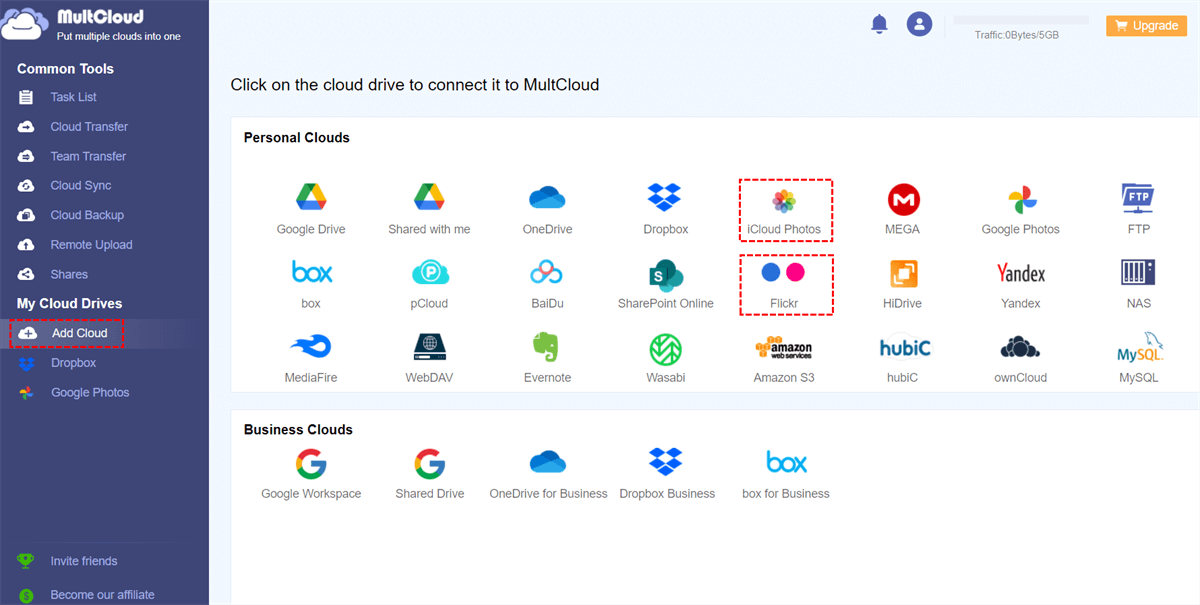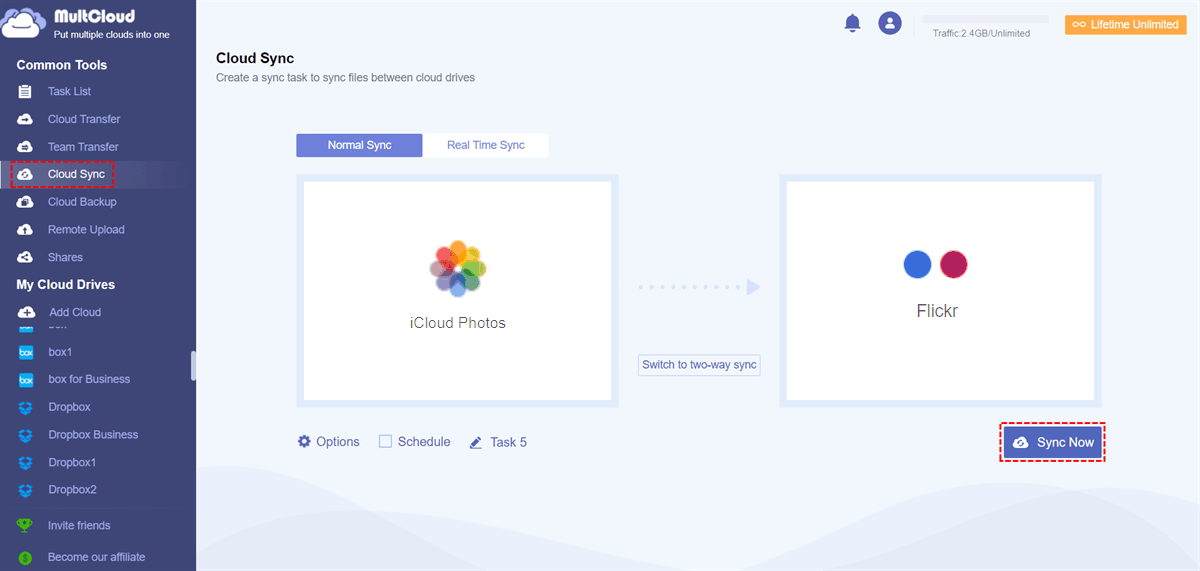Quick Search:
How to Auto Backup iPhone Photos to Flickr
Flickr offers an advanced app called Auto-Uploadr. Literally, it helps you upload and sync photos and videos from iPhone to the cloud. This app is for Flickr pro users, so you are supposed to upgrade your Flickr account. If you have subscribed to Flickr, then follow the step-by-step guidance below to upload Apple photos to Flickr:
Step 1: From your profile, hit the Settings icon > Auto-Uploadr.
Step 2: Turn it on.
You have the option to use WiFi only, or use both Cellular Data & WiFi by turning on “Use Cellular Data”. Once you have set it up, photos and videos from your iPhone's default folder will be uploaded to the cloud. As you can see, the steps are very simple and easy. Now, you can start your auto backup effortlessly.
FAQs Related to Auto Backup iPhone Photos to Flickr
Although the way to set up auto backup Apple photos to Flickr is simple, users might have many questions. Refer to the following content to learn related FAQs:
Q1: What will happen on Flickr if I transfer photos from an old phone to a new phone?
A: Flickr will automatically upload them to the cloud since it treats those photos as new items.
Q2: If I edit a photo on iPhone, will it be uploaded to Flickr again?
A: YES! As long as you make modifications to the photo, the new item will be uploaded to Flickr too. Normal edit changes include rotating, resizing, etc.
Q3: What will happen on Flickr if I delete an image on iPhone and vice versa?
A: Remember that local photos are only uploaded from your iPhone to Flickr. If you delete a photo on Flickr, it won’t disappear on iPhone, and vice versa.
Q4: Can I upload photos to Flickr in original quality?
A: Flickr ensures that no quality loss occurs throughout the process of automatically backup photos to Flickr by allowing you to submit images and videos in their original format.
Pro Tip: How to Sync iCloud Photos to Flickr
As long as you enable iCloud Photos on your iPhone, local photos and videos will be synced to iCloud Photos. However, iCloud only offers 5GB of free space for you to store images and clips. So, it’s often to sync photos and videos from iCloud Photos to another cloud, like Flickr. MultCloud, a cloud sync service, is advised to complete the target more efficiently.
MultCloud is a reliable and professional cloud-to-cloud sync platform that allows you to make one-way or two-way sync between cloud drives directly and effortlessly. Many cloud drives are available on this service, including Google Drive, iCloud Drive, iCloud Photos, Dropbox, OneDrive, Flickr, Google Photos, SharePoint, Amazon S3, Box, etc.

- Real-Time Sync: Automatically sync folders across different cloud storage services in real-time.
- 8 Sync Modes: Offers multiple sync options, including mirror, update, move, and cumulative sync, to suit different needs.
- Schedule Sync: Set up scheduled sync tasks to run at regular intervals automatically. For example, you can sync Dropbox to Google Drive daily.
- User-Friendly Interface: Easy setup and management of sync tasks through a simple and intuitive dashboard.
- Secure Data Sync: Uses 256-bit AES encryption to ensure safe and secure data sync.
After knowing how to auto-backup iPhone photos to Flickr, now, let’s follow the steps below to sync iCloud Photos directly and effortlessly:
Step 1: Sign up for a MultCloud account by visiting its official webpage. Also, log in with your Google, Apple ID, or Facebook.
Step 2: Add iCloud Photos and Flickr respectively by heading to Add Cloud. Then, hit the icon of iCloud Photos to enter your credentials. Don’t forget to permit MultCloud to continue. Next, repeat the same way to add Flickr.
Step 3: Navigate to Cloud Sync on the left. Choose folders from iCloud Photos/or all of the iCloud Photos as the source directory. Select Flickr as the target directory. Next, hit Sync Now.
In this way, the selected photos from iCloud Photos can be synced to Flickr as quickly as possible. To create automatic sync tasks, simply tap the Schedule button. Then, 4 scheduled options are provided for you to choose from. Once you set it up, the task will begin automatically.
Note: How do I transfer photos from iCloud to Flickr? Follow the same way, but just change the source directory to iCloud Drive.
What other features can MultCloud offer to you? Well, there are many advanced features you can enjoy, such as cloud-to-cloud transfer and backup. Similar to the syncing feature, you can set up automatic transfer and backup tasks. MultCloud provides you with a leading migration speed, so large files and folders can be migrated/backed up easily.
Cloud Transfer: No need to download and upload. MultCloud makes it easy to migrate data between cloud services in the background.
Cloud Backup: After backing up data between clouds, you can restore the data without any effort. There are versions you can choose from.
Also, basic features, such as downloading, sharing, and more, are available too. For example, you can upload and share documents to Google Drive. On top of that, a new feature called Image Saver allows you to download images and videos from Instagram, websites, etc. to local devices as easily as possible.
Final Words
That’s all about how to auto backup iPhone photos to Flickr. Anyway, as long as you are a Flickr pro user, you can enjoy the Auto-Uploadr feature to automatically back up your local photos and videos to the cloud. Meanwhile, when you find your iCloud storage is insufficient, you can sync iCloud Photos to Flickr via MultCloud.
If you utilize MultCloud, your cloud management can be a breeze. It allows you to connect multiple cloud drives together in one place. Without frequently switching from one cloud to another, you can manage cloud drives efficiently on MultCloud. It is not only a cloud file manager, but also a smart image downloader online service.
MultCloud Supports Clouds
-
Google Drive
-
Google Workspace
-
OneDrive
-
OneDrive for Business
-
SharePoint
-
Dropbox
-
Dropbox Business
-
MEGA
-
Google Photos
-
iCloud Photos
-
FTP
-
box
-
box for Business
-
pCloud
-
Baidu
-
Flickr
-
HiDrive
-
Yandex
-
NAS
-
WebDAV
-
MediaFire
-
iCloud Drive
-
WEB.DE
-
Evernote
-
Amazon S3
-
Wasabi
-
ownCloud
-
MySQL
-
Egnyte
-
Putio
-
ADrive
-
SugarSync
-
Backblaze
-
CloudMe
-
MyDrive
-
Cubby
.png)


